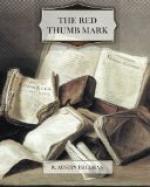“Then,” said Thorndyke, “come round to breakfast to-morrow and we will settle the terms, and you can commence your duties at once. And now let us light our pipes and finish our yarns as though agitated clients and thick-headed solicitors had no existence.”
CHAPTER III
A LADY IN THE CASE
When I arrived at Thorndyke’s chambers on the following morning, I found my friend already hard at work. Breakfast was laid at one end of the table, while at the other stood a microscope of the pattern used for examining plate-cultures of micro-organisms, on the wide stage of which was one of the cards bearing six thumb-prints in blood. A condenser threw a bright spot of light on the card, which Thorndyke had been examining when I knocked, as I gathered from the position of the chair, which he now pushed back against the wall.
“I see you have commenced work on our problem,” I remarked as, in response to a double ring of the electric bell, Polton entered with the materials for our repast.
“Yes,” answered Thorndyke. “I have opened the campaign, supported, as usual, by my trusty chief-of-staff; eh! Polton?”
The little man, whose intellectual, refined countenance and dignified bearing seemed oddly out of character with the tea-tray that he carried, smiled proudly, and, with a glance of affectionate admiration at my friend, replied—
“Yes, sir. We haven’t been letting the grass grow under our feet. There’s a beautiful negative washing upstairs and a bromide enlargement too, which will be mounted and dried by the time you have finished your breakfast.”
“A wonderful man that, Jervis,” my friend observed as his assistant retired. “Looks like a rural dean or a chancery judge, and was obviously intended by Nature to be a professor of physics. As an actual fact he was first a watchmaker, then a maker of optical instruments, and now he is mechanical factotum to a medical jurist. He is my right-hand, is Polton; takes an idea before you have time to utter it—but you will make his more intimate acquaintance by-and-by.”
“Where did you pick him up?” I asked.
“He was an in-patient at the hospital when I first met him, miserably ill and broken, a victim of poverty and undeserved misfortune. I gave him one or two little jobs, and when I found what class of man he was I took him permanently into my service. He is perfectly devoted to me, and his gratitude is as boundless as it is uncalled for.”
“What are the photographs he was referring to?” I asked.
“He is making an enlarged facsimile of one of the thumb-prints on bromide paper and a negative of the same size in case we want the print repeated.”
“You evidently have some expectation of being able to help poor Hornby,” said I, “though I cannot imagine how you propose to go to work. To me his case seems as hopeless a one as it is possible to conceive. One doesn’t like to condemn him, but yet his innocence seems almost unthinkable.”




